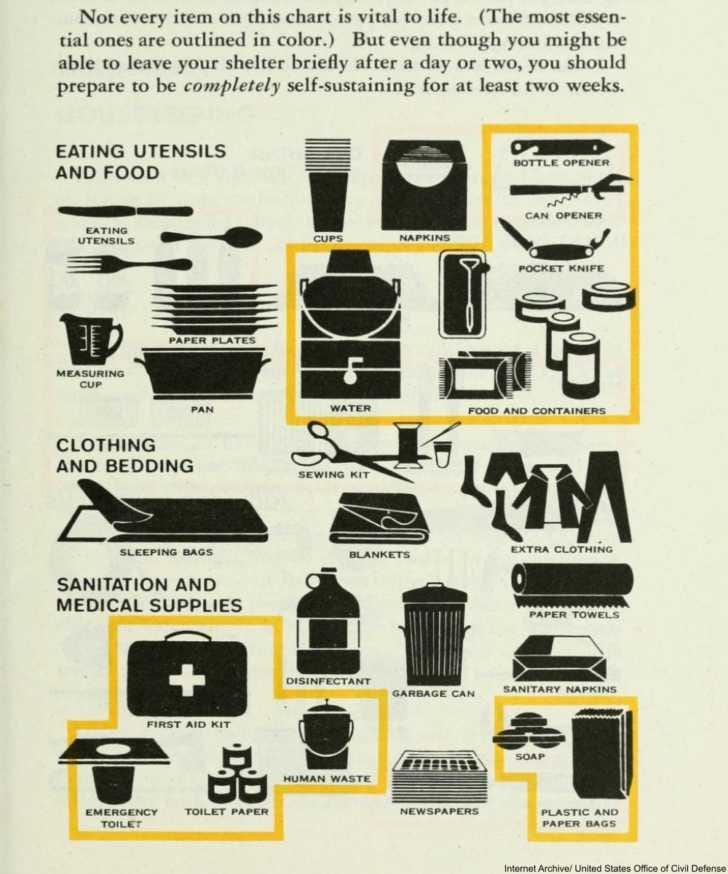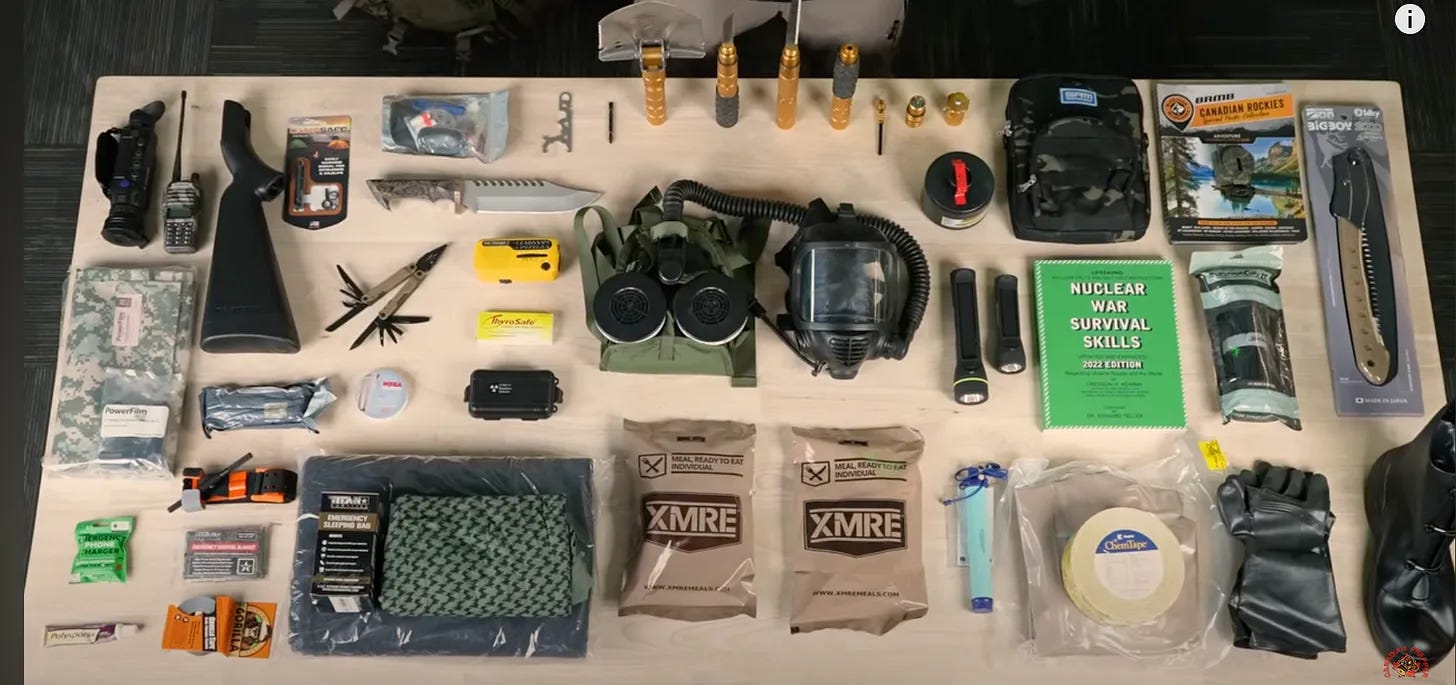Nuclear War Preparedness: Your Guide to Creating an Emergency Survival Kit
Pathetic U.S. Civil Defense Plans Won't Save You
Photo Credit: U.S. Department of Energy
October 4, 2023, the same day FEMA sent a test emergency broadcast message to the American people, was the same day Russia hosted a full-scale nuclear war drill across 11 time zones. What are the odds? In the same token, news articles in main stream media began gaslighting preparedness-minded people with headlines such as “Anti-Vaxxers Think an Emergency Phone Alert Will Cause a Zombie Apocalypse” - Rolling Stone & “Zombie Conspiracy Theories Spread Like Wildfire Ahead of Emergency Alert” - Newsweek. While there were some wild notions floating around social media, one should not throw the proverbial baby out with the bathwater. Treating the very real possibility of nuclear detonation, cyber warfare, Directed Energy Weapons, & Electro Magnetic Pulses occurring as just a boring, easily-dismissible fire drill is to make a potentially fatal mistake.
In my previous Substack article “Civil Defense Planning-America Quit in the 90’s” , I highlighted the United States has not had a Civil Defense Plan in over 30 years whereas nations such as Switzerland, Japan, Israel, Singapore, & Germany all have well-established civil defense plans as well as invested in response training & equipment for their citizens. The bears that we’ve been poking the most as of late, Russia & China, both have extensive networks of bomb shelters & advanced warning systems. Each of the aforementioned country’s citizens actually practice where to go & what to do in an emergency.
Photo Credit: Alexei Babushkin/SPUTNIK/AFP via Getty Images/TNS
If the FEMA alert was the real deal, how many Americans would know what to do, where to go, & have the proper supplies on hand to weather whatever the threat may be? My guess is not too many.
I listed some key elements in an emergency preparedness plan & steps to build a nuclear fallout shelter in the above Civil Defense Planning Substack article. In this article, I will highlight several items of importance to have in your emergency preparedness survival kit/bag taken from my previous Substack article “Nuclear War is Closer Than Ever” in an updated, expanded, & linked format. Keep in mind your emergency bug-out-bag should weigh around 10-15% of your bodyweight. Where your kit falls within the 10-15% range, is highly dependent on your level of fitness & hiking experience.
Fallout Shelter Contents - USOCD
Emergency Preparedness Kit/Bag Contents (the nuclear preparedness items may have to be donned prior to departure):
This is meant for those who live in a high-risk area that may need to evacuate to a safer place.
Nuclear War Survival Skills Updated & Expanded book by Cresson H. Kearny. One of the most comprehensive & easy-to-understand books out there. I suggest having the hard copy for home use & the free PDF copy on a USB stick.
Radioactive Fallout Protection
Get to shelter as soon as possible as fallout begins to drop in the first 24 hours & remain active for the first 2-4 weeks (typical half-life of majority of particles) depending on your location relative to the detonation. Some radioactive particles may remain that way for months to years. Ideally, you would be inside of a bunker if you are in an area of high risk such as:
Cities
Areas Near Military Bases
Areas Near Intercontinental Ballistic Missile Silos
Military Ready to Eat (MRE) or Quick Freeze Dried Meals - the food items are sealed in multiple thick packages which should protect it from fallout. They are durable & do not require any additional preparation.
Personal Protection from Alpha & Beta Particles
Alpha Particles - basic protection of your skin & orifices with no fancy clothing necessary. A Level 4 Disposable PPE Suit would do.
Beta Particles (fast electrons) - requires a level B HAZMAT suit. Prevents particles from accumulating on your clothing. Be sure to have proper decontamination procedures in place as you would not want to bring this suit inside your shelter after a trek.
MIRA II Safety HAZ Suit (around $140) which protects against chemical & biological contaminants.
Mission Oriented Protective Posture (MOPP) Suit - military protective gear used for toxic environments. Benefits over the HAZ suit is that it’s breathable. The HAZ suit can get very hot & uncomfortable around the 30-60 minute mark of wear. The MOPP suit can be washed up to 10 times to decontaminate it. The MOPP suit is flame retardant, compatible with a variety of respirators & gas masks. The cost is around $990.
Chem Tape or Vinyl Duct Tape to seal around gloves & overboots
Thick Chemical Resistant Rubber Gloves and
Thick Rubber PVC Overboots
Gas Mask - standard CBRN gas mask connected via a hose to a PAPR to make it easier to move around with your gear.
Powered Air Purifying Respirator (PAPR)- a battery operated fan pack which does the breathing for you. “Filters increase breathing resistance, and any negative pressure gas mask will cause you to tire faster than you would without one. It can be distracting, but worse still—not everyone has the lung power to use a negative pressure gas mask.” - Canadian Prepper
NATO Spec 40MM Gas Mask Filters to attach to the PAPR
Trenching Tool or Foldable Shovel - a shovel in which you can trench yourself to protect from ambient radiation
Information Gathering Method - Shortwave FM/AM/Police/Weather Radio which is solar &/or hand-crank powered, Handheld Scanner.
Means to Communicate with others in your Group - Two-Way radios, GMRS, or a pack of Baofeng Amateur Two-Way Radios. Especially important tool as there will be an information blackout as phones & internet signals may not work.
Radiation Detection Equipment - a Geiger Counter to determine how radioactive your surroundings are.
Potassium Iodide Tablets - to protect your thyroid from absorbing dangerous amounts of radiation. Adding pure iodine to your thyroid will prevent it from absorbing radioactive iodine from the atmosphere. It is recommended that adults take two per day for 2-4 weeks after a nuclear incident. Have 2-3 boxes/bottles on hand per person in your family just to be prepared.
Personal Firearms Protection - depending on your training & experience, have an AR rifle such as a Henry U.S. Survival AR-7 Rifle (a repeating 22 caliber rifle) which folds into its plastic butt stock. It is lightweight & very portable. Good for hunting & minor self-defense. An alternative may be a Cross Bow if you aren’t looking to draw attention to yourself but this may be cumbersome to carry.
Fishing or Snaring Kit - be careful not to eat the skin or bones from an animal that may be contaminated by radiation. Do not eat bottom-feeding type fish as they may consume radioactive isotopes.
Perimeter Trip Alarm - an alarm to use an early warning signal for intruders & wildlife. This uses primers which release a very loud bang to alert you & hopefully scare off any intruders that may attempt to breach your site.
Thermal Monocular - allows you to see any heat signals regardless of the condition, unlike night vision which may be useless if an object is camouflaged. You cannot hide from thermal imaging. Acquire one with a high resolution, ideally a 640 AMOLED Display /384X288 Microbolometer resolution which should provide a visual distance of several hundred meters.
Portable & Rollable/Foldable Lightweight Solar Panels - initially made for the U.S. military, high-quality panels are rollable/foldable, nearly indestructible, & are able to charge devices in low-light conditions.
Emergency Phone Charger - such as a portable charger/power bank with 10,000mAh of power of up to 12W (if your phone was protected in a Faraday bag when the EMP went off of course).
Survival Knife/Machete - find a portable survival knife which combines the functions of a hatchet & a personal knife.
Multitool - such as SOG, Gerber Dime, or Leatherman Rebar
Foldable Saw - such as a Silky BigBoy 2000 Outback to cut through downed trees or to assist with collecting firewood.
Flashlights - such as a 1000 Lumens, solar-powered, floating, waterproof flashlight which also contains a Micro USB power bank. I suggest having both a battery powered flashlight & a rechargeable flashlight especially if you’re trekking during the winter in limited daylight hours.
Backroad Map Book - of your area. Find a map or atlas which contains detailed topographical data. Most people (myself included) have a difficult time without the use of a GPS. If your electronics are fried, you’re going to need an old school map.
Tritium Lensatic Compass - for accurate land navigation. You aren’t going to want to rely on a cheesy compass someone wove into your tactical bracelet. Especially when it comes to trekking in potentially hazardous radiological conditions. Every foot in the right direction counts.
Survival Cord - 1,000 lb. Military Style Survival Paracord such as SurvivorCordXT. The inside of this cord includes Mil-Style 550 Paracord, 30 AWG Snare Wire, 25 lb. Fishing Line, & Waterproof Tinder. You can take this apart & use the aforementioned threads for various purposes. I haven’t seen anything like it.
Israeli Medical Bandage & Tourniquet - to stop the bleeding in case of serious injury in combination with antibiotic ointment. Make sure you get a high quality tourniquet as I’ve heard of cheap ones snapping in the field. I’ve personally used CAT Tourniquets in the field & I can vouch for their effectiveness when it comes to gunshot wounds. Include basics such as rolled gauze & bandages as well. Tampons can serve a dual purpose; feminine hygiene & wound clotting.
Antibiotic Ointment - such as Polysporin Heal Fast Formula Complete 3 Antibiotics & Pain Relief Ointment. I’m personally allergic to bacitracin so I use petroleum jelly or honey which is a natural antibiotic. Honey packets can also serve as an energy source in case you run out of food.
Shelter - many different types are available, it just depends how much room you want to take up in your pack. Some suggestions include a wool blanket, ultra-light sleeping bag, Tact Bivvy systems, emergency survival blankets, plastic sheathing, or a tarp. If you live in a high insect area, consider a mosquito net for your hammock/shelter.
Shemagh Tactical Scarf Wrap - can be used for a variety of things such as clothing, a bandage, a sling, a mask to protect your face, a cloth to protect your neck from sun & bug bites, just to name a few.
Water Purification - a LifeStraw to filter water &/or water filtration tablets such as Aquatabs. If you use a LifeStraw you will need a means of transporting/storing the water such as stainless steel container/bottle.
Single-Walled Stainless Steel Container - Normally, I’m a 100% pure Yeti fan but I can’t put the Yeti tumblers I have over a fire (nor would I want to). In this instance you will need a single-walled stainless steel container because you can put the container right on a fire & boil water without fear that plastic will melt or gasses explode.
A Compressed Bath Towel/Cloth - compressed into a hockey puck-like tablet, a durable cloth made of pure cellulose material once activated with a little bit of water may be used as a towel, bandage, fire starter (keep dry), wash cloth, etc.
Toilet Paper Tablets - because at some point, you will need them.
USB Stick &/or Copies of Personal Documents - have photographs of your most important documents such as your passport, driver license, home deed, living will, etc. stored on a USB thumb drive. Make sure you shield your USB stick in your backpack in case of EMP using a mini faraday bag. You may want to carry physical copies but they may get cumbersome. You may want to include a hard copy/physical photograph of your family members in case you get separated & others want to help you search for them.
Change of Clothing, Undergarments, & Socks
Medications - ibuprofen, acetaminophen, aspirin, antibiotics, antihistamines, & any prescription medications you or your family members require.
Hiking Boots - a durable sturdy pair.
Backpack - a 45L Tactical Backpack should do the job. Any large bag will do but you want to make sure it has a chest & waist strap to help distribute the weight you are carrying, especially on long treks. You also want to test the backpack once it is full with all your gear. You want to make sure you will actually be able to carry it as long & as comfortably as possible or else you will be dumping valuable items before you even get anywhere.
Emergency Survival Kit Contents: Canadian Prepper






